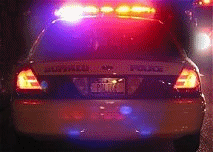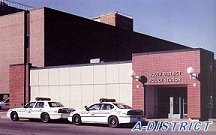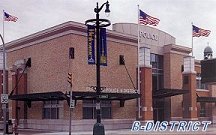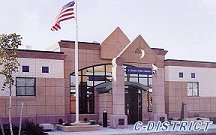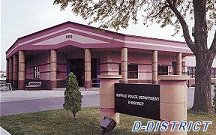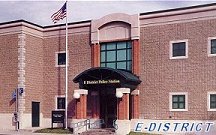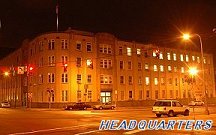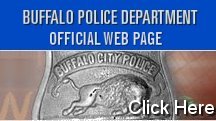
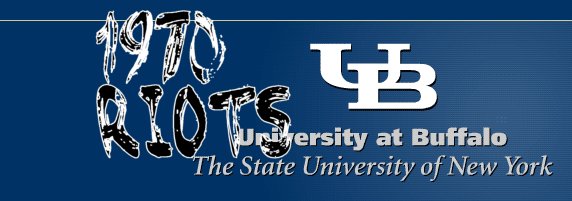 |
|
|
| 1970 Violent Protests at University of Buffalo |
|
|
|
The passing of 35 years offers those touched by violent protests a fresh perspective for reflection By ANTHONY VIOLANTI - News Staff Reporter (a reprint from the Buffalo News, February 20, 2005) |
|
|
|
|
| O'Keefe, Diane Pesch and Mickey Osterreicher in top left photo |
|
|
| The stench of tear gas and student revolt was in the air |
|
|
|
Diane Pesch was marching in front of Hayes Hall at the old University at Buffalo campus on Main Street , facing hundreds of police in full-dress riot gear. |
|
|
|
Michael O'Keefe, a Buffalo tactical patrol officer, was trying to maneuver his police car through dozens of chanting protesters who were swearing, spitting and pounding on the automobile's windows. |
|
|
|
Mickey Osterreicher was gripping a camera and running, trying to take photographs for the student newspaper while fighting the tear gas burning his eyes. |
|
|
|
|
|
|
|
It was March 1970. That year, from Feb. 24 until spring break on March 21, life changed for those three persons and most everybody else at UB. They became part of the most violent and disruptive protest in the school's history. Hundreds of police and thousands of students confronted each other in a clash of cultures and values, with the Vietnam War as the backdrop to it all. In 1970, the university was a hotbed of activism and anti-war activity. |
|
|
|
Unrest began when a sit-in took place before a basketball game on Feb. 24 in Clark Gym. Buffalo police were called to the campus. The next day, 16 people were arrested and at least 11 were hurt in a disturbance that triggered problems for three weeks and gained worldwide publicity. |
|
|
|
|
|
|
|
Dozens of students and professors were arrested; several hundred books were destroyed when a firebomb was tossed into Lockwood Library. Students held a sit-in at the presidential office. There was a student strike, tear gas, property damage and nightly rounds of violence and confrontations. Diane Pesch, now Diane Pesch-Savatteri, had grown accustomed to the big campus where student radicals and activist professors often held sway. "I wasn't a radical," she said. "Like most of the students, I was in the middle. But I was certainly against the Vietnam War." |
|
|
|
She remembers marching in front of Hayes Hall. "The whole thing just didn't seem real," she said. "I started marching, and I saw all these Buffalo police lined up in riot gear. There was tear gas. I saw police clubbing students, they were chasing students. I kept thinking, "Oh my God, it's here, this can't be real, but it's happening.' " |
|
|
 |
|
|
|
Why was she there? |
|
|
|
"That was a time when you wanted to expand yourself and listen to all ideas," Pesch-Savatteri said. "It was a time of change, and you knew change was coming. I felt I could be a part of change by marching." The experience of 1970 had a lasting effect. "It changed my life," she said. "It made me realize there was so much beyond my own little world. I changed my major, from teaching to social work. I felt I could change society that way." |
|
|
|
Caught in the middle |
|
|
|
Mickey H. Osterreicher was a photographer at the Spectrum in 1970. "It was the first time I ever experienced anything like that; I grew up in New York City and never had any encounters with police," said Osterreicher, who later worked as a photographer for the Courier-Express and as a cameraman for Channel 7. He is now a lawyer in Buffalo .Osterreicher learned an important journalistic lesson caught between police and students."I thought, being a journalist, you're just an observer," he said. "But when you get tear gassed, you're no longer just an observer, you're right in the middle, and it doesn't make any difference if you have a camera or not. The lines were blurred. You couldn't help but feel involved." |
|
|
 |
|
|
|
The UB protest was part of a much larger anti-war movement at colleges throughout the country. Hundreds of colleges held protests during the spring of 1970, and four students died at Kent State in Ohio , while two were killed at Jackson State in Mississippi . "Thank God no one was killed at UB," Osterreicher said. "Ultimately, I think it did have a positive effect. Eventually, we got out of Vietnam . Unfortunately, I feel like history is repeating itself in Iraq ." |
|
|
|
Today, Osterreicher's son, Ian, is a member of the U.S. Air Force ROTC. "I'm very proud of him for wanting to serve his country," his father said. "I feel that way about everyone in the armed forces. This is a different time. We have to support our troops, no matter how we feel about the war." The experience "broadened my horizons," |
|
|
|
Osterreicher said. "I worked for the campus paper, but the protests went out into the streets, and I covered them. Then I went to Washington during another protest." During that era, Osterreicher covered many trials, including the Attica prison riots. He became fascinated with lawyers and the law, and he eventually became a lawyer. |
|
|
 |
|
|
|
An officer's scare |
|
|
|
In 1970, Police Officer Michael O'Keefe and his partner were in a patrol car near Main and Minnesota streets, not far from the UB campus, when a group of protesters threw a brick through a bank window. |
|
|
|
O'Keefe and his partner tried to drive through the crowd to get to the bank. "They kept beating on the roof, spitting, swearing and throwing things at us," said O'Keefe, now retired. "It was crazy, everything was boiling over, and I was scared out of my wits." |
|
|
|
O"Keefe said more protesters ran to the scene, and they started to build a fire by a police barricade. By the time O'Keefe left the bank, bonfires were ablaze, he said, adding that protesters were throwing rocks at the police car. O'Keefe jumped back in, and he and his partner made it down a side street. |
|
|
|
Looking back, O'Keefe has been able to see the conflict from both sides. |
|
|
|
"I always felt a lot of good kids got caught up in this. There were some bad kids and agitators, but there were a lot of good ones. We took a few lumps, and I'm sure students took a few lumps from the cops." |
|
|
|
O'Keefe's biggest regret was missing the baptism of his daughter, Mary Pat, when he was on riot duty. |
|
A few years after the UB unrest, O'Keefe and other police officers took part in a program with the university to interact with students. |
|
|
|
"The kids would drive with us in a patrol car, and we got to talk with them. I think they saw we weren't the enemy, and I think a lot of cops came to like the kids, or at least understand them," he said, adding that two of his sons, John and Paul, would graduate from UB. |
|
|
|
During the 1980s, O'Keefe remembers working another protest in downtown Buffalo . This time, the police received overwhelming community support for restoring order, O'Keefe said, adding, "it's a different country now." |
|
|
|
Living with guilt |
|
|
|
David Graley participated in student marches at UB. Today he is a marketing director for an insurance company in South Carolina and describes himself as a conservative Republican. |
|
|
|
"I was young and very impressionable, and UB was a very liberal institution," Graley said. "The campus went kind of crazy, and I got sucked into it. But as you get older, you find out it was a bunch of bull." |
|
|
|
One lasting memory for Graley in 1970 was sitting in geology class as rocks came crashing through the classroom windows. "I didn't understand why those people throwing those rocks were trying to stop the war but hurt me," he said. Graley also remembers a nighttime dash through the parking lot to get to his car as police fired tear gas. |
|
|
|
One thing still pains Graley: the protests against the Vietnam War that criticized the soldiers fighting it. "I feel very guilty about that," he said. "I have quite a few friends who are Vietnam veterans, and I have apologized to them." |
|
|
|
In 1970, Mark W. Huddleston was president of the UB Student Association. He later taught at UB and was recently named president of Ohio Wesleyan University in Delaware , Ohio . |
|
|
|
As head of the Student Association, Huddleston was caught in the middle, dealing with faculty and administrators while trying to represent students. |
|
|
|
"We felt pressure from the extreme left with their demands, but we also felt pressure from the other side," Huddleston said, adding he favored "the classic liberal education rather than the brick-throwers." |
|
|
|
The experience, like the times, was confusing. |
|
|
|
"It's hard for me to say what the lessons were or the impact of what happened at UB in 1970," Huddleston said. Somehow, those old days of campus revolt have taken on a kind of nostalgia. "I think there's a kind of wistfulness from baby boomers about what happened during that time," he said. "The baby boom generation has always been narcissistic. We spent too much time looking in the mirror and thinking it was all about us." |
|
|
|
William R. Greiner has spent more than five decades at UB. In 1970, he was a law professor, and he later served as the university's 13th president. |
|
|
|
The 1970 unrest was "a traumatic, stimulating and very disturbing time," Greiner said. It ended what he called "the surrogate parent" role of the university. No longer could it control personal student issues, from dorm life to demonstrations. |
|
|
|
Students were determined to end "war and racism, and the university became a target," Greiner said. "When you're young, you want to make a statement and change things. People had this idea of going to the barricades and acting like revolutionaries. The campus was ripe for people to act up and act out. They were challenging fundamental values. |
|
|
|
"What happened in those days led to a conservative backlash," Greiner added. "I think students today are much more conservative." |
|
|
|
But many of the students who took part in the 1970 protests feel it was worth it. |
|
|
|
"I'm proud I was there," said Diane Pesch-Savatteri, whose daughter, Anna, is a student at UB. "To this day, I tell my children you have to fight for what you believe. And you've always got to question the government, because they don't always tell the truth." |
|
|
|
Pesch-Savatteri recently visited the campus and took a stroll with her daughter. |
|
|
|
"It seemed," she said, "pretty quiet." |
|
|
|
Exploring the protests |
|
|
|
A detailed history of the event can be found online at the alumni magazine "UB Today" at www.buffalo.edu/UBT/features/. e-mail: aviolanti@buffnews.com |
|
|
|
|
|
During the 1970's. Lieutenant Jerry Fusani was a young cop in the Narcotics Squad working undercover on the UB campus. Lieutenant Fusani witnessing the whole thing from the student's perspective. He was making drug buys and attending their meetings at night. Lieutenant Fusani found aspects of his assignment amusing, He would be with a group of students yelling at the "pigs", and police officers from the TPU would see him in the crowd and knew who he was. Lieutenant Fusani made sure he didn't get too close to them, He was sure the officers would have tried to "stick" him too. , |
|
|
|
|
|
Photo provided by Lt John Rieman |
|
Text provided by T.J. Pignataro, Buffalo News |
|
|
POLICE OFFICERS
Chief Executives
Police Officers
Police Woman
History of Black Officers
Officers Memorial
Precinct 16
S.W.A.T.
Cold Case Squad
Underwater Recovery Team
Mounted Division
Motorcycle Squad
K-9 Corps
Communications
Band and Drill Team
Cartography Unit
Printing Department
Pawnshop Squad
History Overview
Police Precincts
Mutual Aid
World War II
Desert Storm
Detectives 1980
The Blue Ribbon Gang
The Mystery Perfume Case
The Felons Fang
Contract For A Hit
An Eye For Murder
The Boarder Bandits
Detective William Burns



